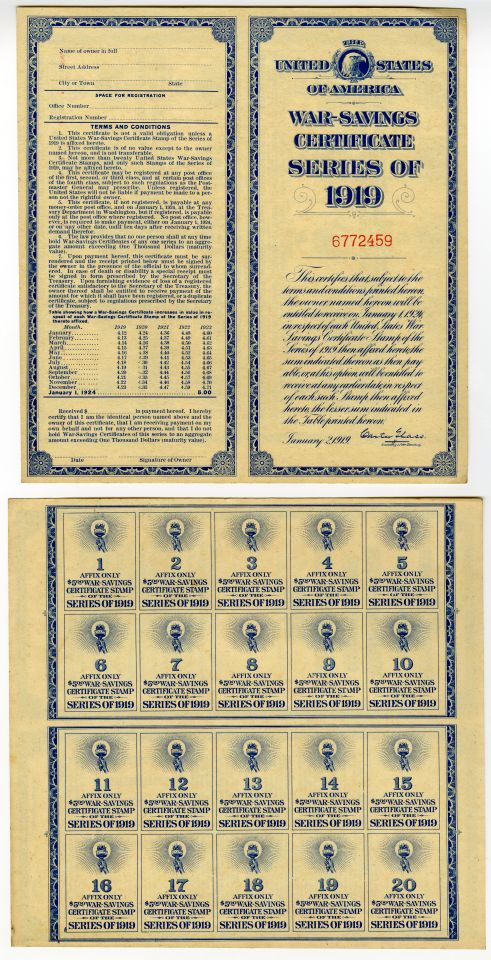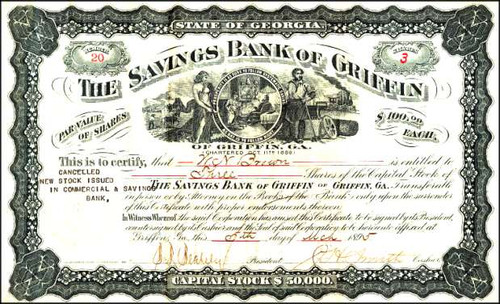Series of 1919 $5.00 War Savings Certificate Booklet . Printed signature of Carter Glass as Secretary of the Treasury. Very Fine and scarce. Scott No. WS3 
War Savings Certificate Booklet War savings stamps were issued by the United States Treasury Department to help fund participation in World War I and World War II. Although these stamps were distinct from the postal savings stamps issued by the United States Post Office Department, the Post Office nevertheless played a major role in promoting and distributing war savings stamps. In contrast to Liberty Bonds, which were purchased primarily by financial institutions, war savings stamps were principally aimed at common citizens. During World War I, 25-cent Thrift stamps were offered to allow individuals to accumulate enough over time to purchase the standard 5-dollar War Savings Certificate stamp. When the Treasury began issuing war savings stamps during World War II, the lowest denomination was a 10-cent stamp, enabling ordinary citizens to purchase them. In many cases, collections of war savings stamps could be redeemed for Treasury Certificates or War Bonds. The United States Treasury Department issued its first war savings stamps in late 1917 in order to help pay for the costs incurred through involvement in World War I. The estimated cost of World War I for the United States was approximately $32 billion, and by the end of the war, the United States government had issued a total of $26.4 billion in debt. Although national campaigns had aimed to sell $2 billion in war savings stamps, they ultimately accounted for about $0.93 billion, or 3.5 percent, of the total debt issued. Despite the low proportion of total debt purchased as war savings stamps, they represented real additional savings whereas other issues were at least partly monetized already.[1] In addition, government and society leaders utilized the war savings stamps program as a vehicle to teach the importance of saving and thrift. The primary, interest-earning stamp issued was the War Savings Certificate stamp, which was worth 5 dollars at maturity on January 1, 1923. These stamps needed to be affixed to an engraved folder called the War Savings Certificate, which carried the name of the purchaser, and could only be redeemed by that individual. Between December 3, 1917 and January 31, 1918, each stamp could be purchased at the price of $4.12. If purchased on January 2, 1918, the return on the investment would be 4 percent, compounded quarterly. The price of the stamp increased by one cent for each month after January 1918 until sales ended in December 1918. Owners of these stamps could also redeem them for cash prior to the maturity date and receive the amount paid plus one cent for every month after the original purchase. The Treasury issued a new series of War Savings Certificate stamps in subsequent years, with the same interest rate and time to maturity. The final series of War Savings Certificate stamps were issued on December 21, 1920, maturing on January 1, 1926. History from Encyberpedia and OldCompany.com (old stock certificate research service)

War Savings Certificate Booklet








